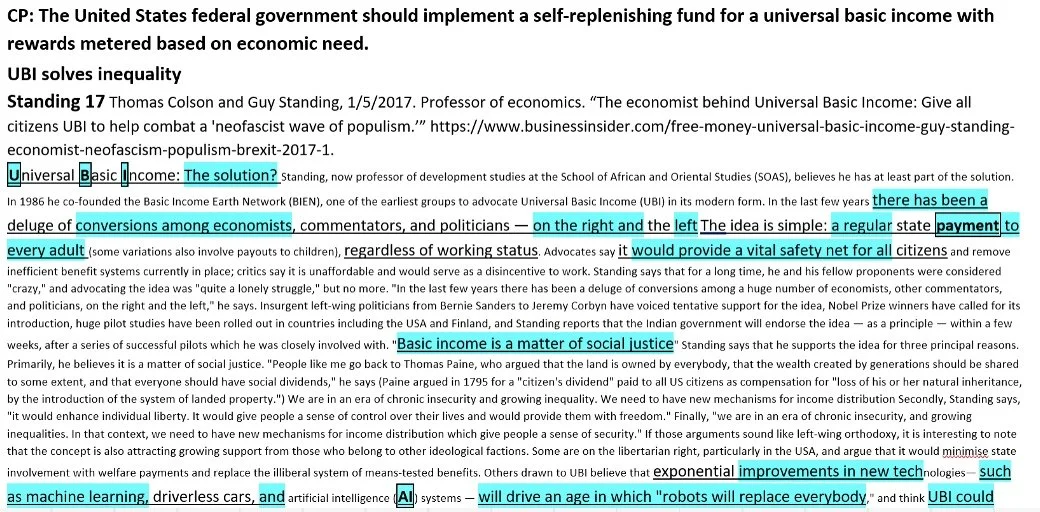Intro to Counterplans
The Role of the Negative
The role of the negative is to prove the resolution is false/a bad idea.
We just discussed negative contentions, but what are some other ways we could prove the resolution false?
What is a Counterplan?
A counterplan is a counter advocacy in the debate by the negative. A counterplan is another method of proving the resolution is a bad idea. It does this by saying that there is a better method to solve issues than the AFF. If something isn’t the best idea, then it’s not something we ought to do.
Parts of a CP
The negative’s counterplan is made up of:
The Counterplan text, Solvency Cards/Explanation, and the Net Benefit
Counterplan Text
Explanation
The counterplan text is the exact wording of the negative’s alternative proposal. It outlines what the negative is advocating for instead of the affirmative plan.
Just like the affirmative has a plan text, the negative needs a counterplan text that clearly explains:
What the counterplan does
Who does it (the agent)
How it solves the harms or advantages claimed by the AFF
The counterplan text should be precise and specific.
Solvency Cards/Explanation
Explanation
This part explains why the counterplan can solve for the affirmatives contention(s).
Typically uses a card or a “highlighting” of your opponent's card
You usually need to win that it solves most of your opponent’s case.
Solvency Card for UBI
Typically uses a card or a “highlighting” of your opponent's card.
Net Benefit
Explanation
The net benefit is the reason why we should only do the counterplan instead of the affirmative (AFF). It’s the negative's key contention that proves the affirmative is a bad idea.
To evaluate a counterplan, judges typically look at two questions:
Can the counterplan solve the affirmative’s harms?
Is it possible to do both the affirmative and the counterplan?
If the answer to the second question is “no” and the net benefit is true, then the counterplan alone is the better option.
Answering a Counterplan
There are three types of arguments to make when answering a counterplan.
Deficits
Explanation
A deficit is a part of the affirmative case that the counterplan fails to solve. It is one of the simplest and most important ways to respond to a counterplan.
Deficits show that the counterplan does not fully address the affirmative's advantages. The larger the deficit, the stronger the argument for the affirmative. If the counterplan cannot solve a key part of the case, the judge has a clear reason to vote for the plan instead.
Even a small chance that the counterplan misses something important can justify voting affirmative. This is why affirmative cases should include specific, unique advantages. It makes it easier to prove that only the plan can solve them.
Permutations
Permutations are arguments that show why it’s better to do both the affirmative plan and (some or all of) the counterplan, rather than just the counterplan alone. They’re used to prove that the counterplan doesn’t truly compete with the affirmative.
Perm Do Both
This argues that doing both the AFF and the counterplan is not only possible, but also a good idea. To win this argument, you have to show that there’s no real reason not to do both—and that doing both avoids the net benefit the negative is relying on. However if a counterplan just says its bad to do both, you need to win that the net benefit is either untrue, or equally true for the counterplan.
Example:
The AFF says we should get a dog
The NEG says we should get a cat
If there is no net benefit: PERM DO BOTH is better than just the counterplan alone.
Shields the link: Means that the there is no link to the net benefit if we do both.
Perm do the counterplan
The counterplan is just the AFF.
Perm do the counterplan typically applies to counterplans that are incredibly similar to the AFF.
Example:
The AFF says we should go to space.
The counterplan says we should go to the moon.
Clarifications
Obviously, the counterplan is just a more specific way the AFF could be done. This means that the counterplan has not proven the aff is a bad idea, since it advocated for a method of doing the AFF. If you make a permutation, you don’t have to defend it for the rest of the debate. The permutation is not an advocacy it’s just a way of testing to see if the counterplan competes with the AFF.
You can read more than one permutation. Each permutation is just a different arg to test of the counterplan competes with the AFF.
Answers to the Net Benefit
While the other arguments are the main ones to make, under some circumstance, focusing on the net benefit can be more strategic. Even if the counterplan can solve the affirmatives case, winning turns on the net benefit means the AFF is still a better idea.
Example:
1AC: We should go to the park
Contention–We’ll have fun
1NC We should stay home and play video games.
Solves the case—Video games are fun
Net benefit too much sunlight in the park
If the affirmative wins that sunlight is good, the net benefit is just a reason to vote for the AFF.

